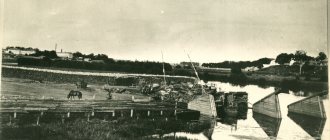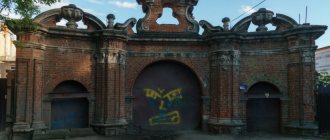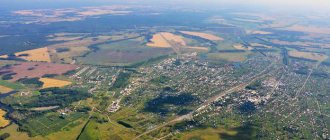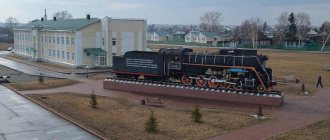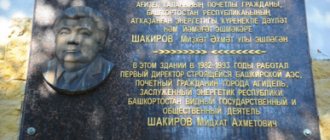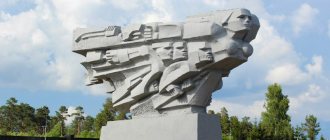Tsivilsky district.
Unlike the city of Tsivilsk, formed back in the 16th century, Tsivilsky district is a very young administrative-territorial unit and includes 17 municipalities. These are mainly rural settlements. Tsivilsk is the only urban settlement. Despite the fact that the area of Tsivilsk does not exceed 9 km2, 40% of the residents of the entire area live there. The Anish, Big and Small Tsivil and Unga rivers flow through the territory of the Tsivilsky district. You also need to be especially careful here: at every step there are numerous ravines with a depth of 5 to 35 m and a length of 10-12 m.
There are also about thirteen peat deposits in the area, which are used by local residents to heat their homes.
This area does not shine with forest oak groves and thickets. Most of the territory is occupied by vast fields with small “islands” of birch and oak trees.
The main “Field of activity” of the residents of the Tsivilsky district is agriculture and cattle breeding. Also, hop cultivation predominates here: based on this, there is its own brewery.
Tsivilsk - city, Tsivil - river, etymology
And the Piskarevsky chronicler (1600-1650) ordered them to take off with them (Church Slav. gather) at the mouth of Tsyvilsky.
1) General information
a) Tsivilsk (Tsyvilsk until 1840) is a city in the Chuvash Republic of Russia, located at the confluence of the Bolshoi Tsivil and Maly Tsivil rivers, then Tsivil (Tsaval). Founded in 1589 as a fort, the first inhabitants were archers, gunners, clerk builders, boyar children, and clergy.
* Tsivil - Bol River. Tsivil (Chuvash. Măn Çaval), length 172 km, depth -1-3 m, near the city of Tsivilsk it merges with the Maly Tsivil River, then as Tsivil flows into the Volga. The spring flood is violent, often the river overflows its banks and floods the floodplain. From the mouth to the city of Tsivilsk, the river is navigable during April, May, September, October for flat-bottomed barges, motor boats and rafts; previously it was fuller.
The etymology of the hydronym Tsivil (Chuvash. Çaval (Tsaval)) has not been established.
b) ESBE/Tsivilsk - district. mountains Kazan province, on the right. bank of the river Bol. Tsivilya (near the confluence of the Malaya Tsivilya River), in the north-west. corner at The time of the founding of the Church is unknown. Ts. was first mentioned as a city in 1584, when, by order of Boris Godunov, a fortress inhabited by Russians was built here. ... In times of troubles, in 1609, the Cheremis were taken and burned; in 1671 the city was attacked by one of Razin’s gangs; in 1773 the city was captured by Pugachev's gangs.
* ESBE/Tsivil - river. Kazan province, right. adv. Volga; made up of a merger pp. Bol. and Mal. Ts.; both C. flow from the swamps to the south. part of Yadrinsky district, on the border of Simbirsk province. and before their confluence they flow parallel to each other to the NE, irrigating the uy. Yadrinsny, Tsivilsky and Cheboksary. Total length (Bol. Ts. and Ts.) 143 ver.; The banks are open with steep slopes to the water, partly covered with oak forests. Navigable Ts. for the 15th century. from the mouth to the village. Elnikovo (shipping company). In 1900, 10 ships with a grain cargo of 475,000 pd were sent along the Central. The Middle Ts., Bol. flow into the Ts. Sorma, Kukarka and others.
2) Toponym in Old Russian documents
* Chronicler of the beginning of the kingdom of the Tsar and Grand Duke Ivan Vasilyevich (1553-1555): “On the 20th month of November, in the week, the Tsar and the Grand Duke sent their governor Prince Dmitry Fedorovich Belsky and his other governors before him to Volodymer and ordered them to Volodymer with the people brother, and from Meshchera he ordered Tsar Shigal to go and with him the governors Prince Volodimer Vorotynsky and others, and he ordered them to take off with him at the mouth of Tsyvilsky.”
Note SHAH-ALI, Shigaley (1505-1567) – ruler of the Kasimov kingdom and the Kazan Khanate. In 1551, together with Russian governors, he supervised the construction of Sviyazhsk, at the same time Chuvashia became part of the Russian state. In 1552, the Kasimov army led by him took part in the capture of Kazan. Shah Ali and Kasimov's Tatar army played a significant role in the annexation of Middle East. Volga region to the Russian state.
* Book called the New Chronicler, 17th century; https://www.vostlit.info/Texts/rus13/Nov_letopisec/... 10. About the conquest of the Kazan people to Tsar Fyodor Ivanovich. Having heard these filthy Kazan people that the Moscow Tsar Fyodor Ivanovich sat down as king, and God brought them, such a filthy people, to such a righteous sovereign, without war and without blood, they all came with humility and asked for mercy. He, the generous and righteous sovereign, accepted them, forgave them their guilt and granted them his full sovereign salary and sent them away to him. The righteous sovereign himself, having examined and expecting treason from them in the future, sent his governors and ordered to establish cities throughout the Cheremis land - they placed the cities of Kakshuga, Tsivilsk, Urzhum and many others on the Nagornoy and Meadow sides, and planted them with Russian people, and thus he, the sovereign, strengthened the entire kingdom of Kazan.
* Rate book 1475–1598. Rank 1512–1598: “{l. 622} In the Tsar's city, on Kokshag, Vasily Petrov, son of Golovin. In the Tsyvil city the head is Vasily Nepeitsyn.”
* N.I. Kostomarov. Russian history in the biographies of its main figures. Issue three: XV-XVI centuries (1862-1875): “Thus, to tame the Cheremis, Boris ordered the construction of Tsivilsk, Urzhum, Tsarevo-Kokshaysk, Tsarevo-Sanchursk along the banks of the Volga, and downstream of the Volga Saratov, Perevoloka, Tsaritsyn” .
3) Topography
General map of the Kazan province of Fyodor Cherny in 1779, district town. Plan of the city of Tsyvilsk in 1796. Special map of the Western part of Russia by Schubert 1826-1840. Plan of the city of Tsivilsk in 1847. Monastery husband — 1 (founded in 1675). There are 10 stone churches, 14 wooden churches. Residents' trades: the advantage is arable farming, partly trade. The soil of the land is predominantly black earth. Military topographical map of the Kazan province 1880, 243 yards.
4) Generalization and conclusion
According to Russian chronicles, the city of Cheboksary has been known since 1469 (it existed earlier), during the campaign of governor Ivan Dmitrievich Runa to Kazan, Sviyazhsk was built in 1551. The Civil River is located between them, closer to Cheboksary. Historical sources show that the military-administrative figures of the Russian state knew the TSIVIL River before the appearance of the city of Tsivilsk under Tsar Fyodor I Ivanovich (Tsar 1584-1598). The mouth of the Tsivil River served as landmarks and a gathering place for troops during campaigns against Kazan; the name is enshrined in the chronicles. The city of Tsivilsk was originally a fort, a military settlement, its name came from the river.
Conclusion It is advisable to consider the toponym in connection with biblical terminology and images. It is necessary to look for concepts: army, army, army, gathering of troops and the like.
5) Hebrew terminology and biblical image
a) Terminology
CIVIL = CIV + IL. TSIVILSK = TSIV+IL+SK (SK read the other way around - Hebrew KES throne, i.e. royal city).
* TSYV, TsIV = Hebrew. TSAVA צָבָא to go forward, to wage war, to fight, to go to war, to gather, army, army, militia; derivative TZEVAA צְבָאָה army, army, go out to war, service, host of angels (Army of God); Tsevai military, military.
* IL - translation into Russian of the name of God, a theophoric name. For example: Ilya (Elijah) - personal name, Russian version of the biblical name of ancient Hebrew. Eliyahu, Yahweh is my God; prophet of the Old Testament. In the name Eli+yahu: ELI is my God; YAHU is a short form of the Unpronounceable Name of God. A theophoric name (from the Greek Theos - God), which includes the word “God” itself or its names.
General form
CIVILE = TSYV+IL = Hebrew. TSAVA צָבָא go to war, gather a militia, service, army + EL אֵל God; those. border, river basin, a gathering place for troops - the militia of God.
Hydronym is the name of the line of confrontation on the military border of the Russian kingdom with the Kazan Khanate (1438-1552), the Tsivil River basin was not yet annexed to the Russian kingdom, but was no longer controlled by the Kazan Khanate. Wars in the Middle Ages had a religious ideological justification (understandable to ordinary people - a war with infidels), behind which the purely material interests of the ruling elites were hidden. As a result of the five Kazan campaigns of Ivan the Terrible (1547-1556), the territories of the Khanate were devastated, and Russian administration was introduced everywhere. The Kazan Khanate ceased to exist, the territories became part of the Russian kingdom.
Source *See Lexicon by Strong and Butler, EL; https://www.obohu.cz/bible/index.php?styl=WEC&hs=H... Strong's number: H410. Original: אל. Pronunciation: el. Part of speech: Masculine noun. Etymology: shortened from H352 - 1. strength, power; 2. God, god. *See Lexicon by Strong and Butler, CAVA; https://www.obohu.cz/bible/index.php?styl=WEC&hs=H... Strong's number: H6635. Original: צָבָא. Pronunciation: tsaba′ tseba′a. Part of speech: Masculine noun. Etymology: from H6633 - 1. army, army, army, militia; 2. service, service (military or religious).
b) Biblical image
* Isaiah 43:12: “It is I who have told, who have delivered, who have proclaimed, and not by someone else! And you are My witnesses, says the Lord. “I am God (EL)!” * Job 33:6: “Before God (EL) I am the same as you, I myself am molded from clay.” * Numbers 31:6: “And Moses sent them to the war (ZAVA), a thousand of each tribe, them and Phinehas the son of Eleazar the priest, to the war, and in his hand were the sacred vessels and trumpets for alarm.” * Joshua 5:14: “Neither one nor the other,” he answered. “I am the leader of the army of the Lord (CEVA), and that is why I am here.” Jesus prostrated himself before him and asked, “What will my lord say to me his servant?”
* EEBE/Names of God Tsebaot, ... - The names Yahweh and Elohim are often found in the Bible together with the word “tsebaot” (“armies”), such as Yahweh Elohi Tzavaot - “Lord God of hosts”, and most often simply Yahweh Tzebaot - “ Lord of hosts." To the last expression... the name of God “Adonai” is often added, from which arises the very common title of the Lord - “Lord Lord of hosts.” This is a composite I.-B. found mainly in prophetic literature and completely absent, for example, in the Pentateuch, in the books of Joshua and Judges. The original meaning of the word "Tsebaoth" appears to be given in I Sam. 13, 4). But, in addition to this special use, this word also means armies or military hordes of people, as, for example, in the book. Ref. (6, 26; 7, 4; 12, 41), while “tsaba” ... in the singular is also used to designate the heavenly army.
Thus, the name of the Tsivil River indicates the border territory into which the Russian Empire entered approximately the period 1500-1550. in the confrontation with the Kazan Khanate - a military border, a line. Russian administration appeared on the Tsivil River under Tsar Fyodor I Ivanovich from approximately 1584-89. In 1625, 26 boyar children, 250 archers with their heads, 5 gunners, 3 collars, 10 service Lithuanians, Cherkasy, Germans and others lived in Tsivilsk. 2 infantry centurions, 4 interpreters - a total of 301 people.
Chisinau, April 28, 2021


